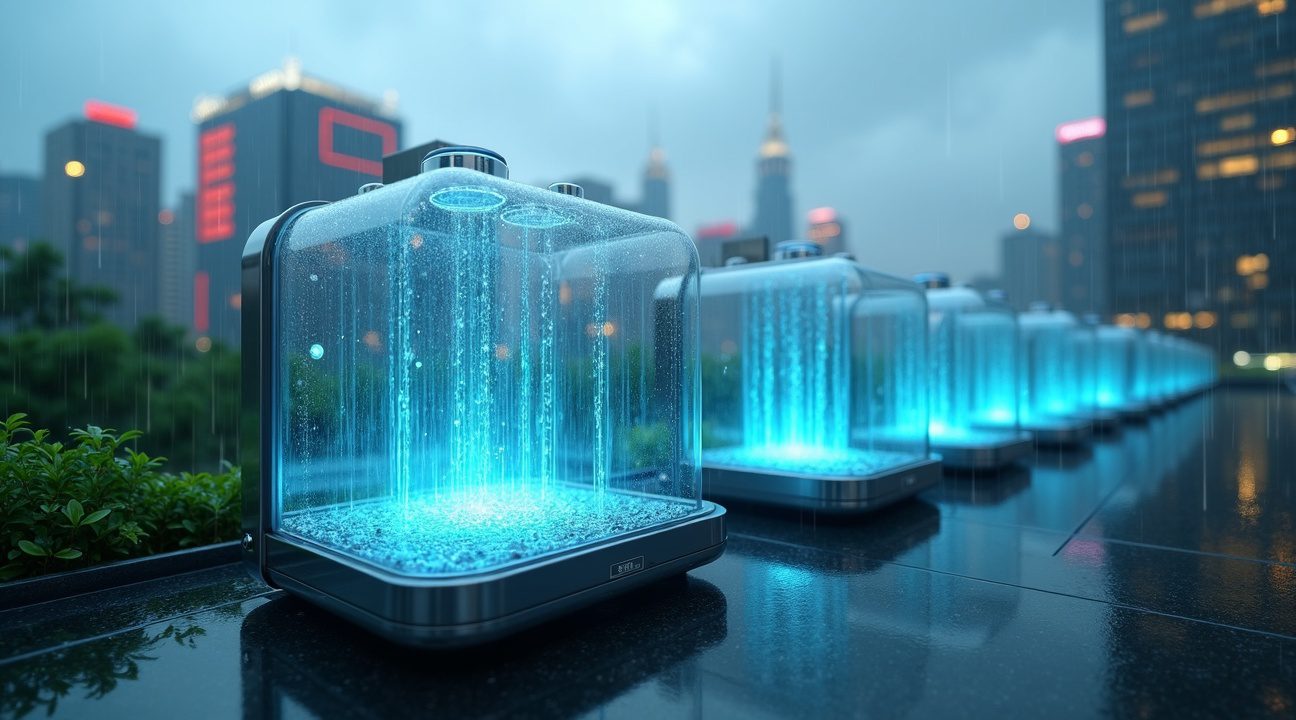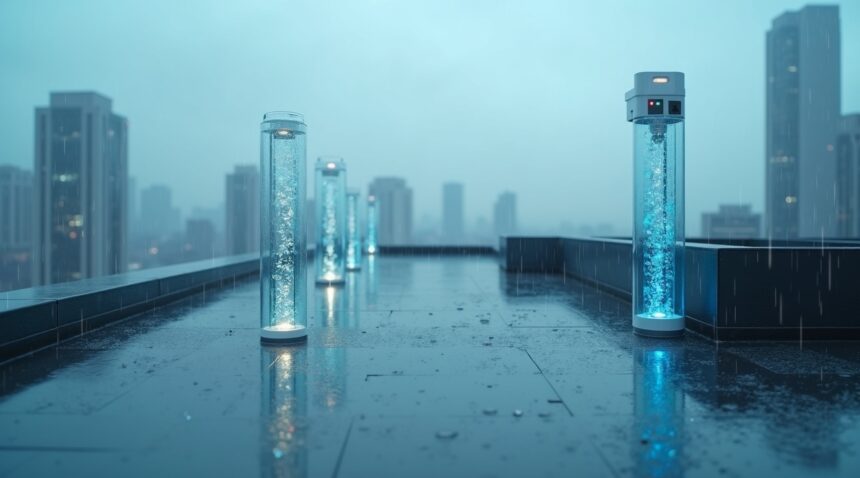Researchers at the National University of Singapore have unveiled a pioneering “plug flow” technology that harnesses the kinetic energy of falling raindrops to generate electricity, significantly outperforming traditional water harvesting systems.
Key Takeaways
- High Conversion Efficiency: The plug flow system converts over 10% of the kinetic energy from raindrops into electricity, marking a remarkable 100,000-fold improvement over standard continuous flow techniques.
- Effective Power Output: Laboratory results showed that a single 32-centimeter conductive polymer tube can generate 440 microwatts of power, and four such tubes can power 12 LED light bulbs for 20 seconds.
- Innovative Tube Design: The system uses narrow polymer tubes that form segmented water-air patterns within, enhancing charge separation and thereby maximizing energy recovery from each droplet.
- Urban Sustainability Potential: With Singapore experiencing around 171 days of rainfall each year, this technology is highly suitable for consistent energy generation from urban rooftops or other built-up areas.
- Infrastructure-Free Deployment: The lightweight and compact design requires no dams or large reservoirs, enabling painless integration into existing city architecture without harming natural ecosystems.
Implications for Renewable Energy
Beyond efficiency, what sets this approach apart is its sustainability and scalability. Unlike traditional hydroelectric systems that rely on large water volumes and massive installations, this method uses everyday rainfall — turning city-level precipitation into a reliable power source. It paves the way for decentralized energy networks in densely populated areas.
To understand more about this innovative project, you can visit the National University of Singapore’s official site.
Revolutionary “Plug Flow” System Converts Rain Droplets Into Usable Power
Researchers at the National University of Singapore have created a groundbreaking technology that transforms individual rain droplets into electrical energy through an innovative “plug flow” effect. This system represents a fundamental shift from traditional hydropower generation, capturing energy from the smallest water movements rather than relying on massive water volumes.
How the Plug Flow Technology Works
The technology operates when rain-sized water droplets travel down a narrow, vertical conductive polymer tube filled with air bubbles. Water naturally breaks into discrete columns separated by air gaps as it moves through the tube, creating a unique pattern that scientists call the plug flow effect. This process enhances charge separation at the solid-liquid interface, allowing for efficient electricity generation from each droplet.
The system exploits the movement of water droplets across specific surfaces to create electrical charge separation, functioning similarly to static electricity generated by rubbing a balloon against hair. When droplets interact with the conductive polymer surface, they create electrical charges that can be harvested and stored for practical use. Each droplet becomes a tiny power generator, accumulating energy as it moves through the specialized tube structure.
Advantages Over Traditional Hydropower Systems
This rain-harvesting technology differs dramatically from conventional hydroelectric systems in several key ways:
- Operates using natural rainfall without requiring dams or large water reservoirs
- Captures energy from individual droplets rather than massive water flows
- Functions independently of geographic location or water table access
- Requires minimal infrastructure compared to traditional hydroelectric plants
- Works continuously during rain events regardless of season or weather patterns
Unlike traditional hydropower, which depends on the kinetic energy of large water volumes flowing through turbines, this system taps into small-scale water movement. The technology eliminates the need for the massive energy infrastructure typical of hydroelectric dams, making it accessible for urban environments and areas without significant water resources.
The plug flow system can operate in locations where conventional hydropower isn’t feasible, including rooftops, urban areas, and regions with intermittent rainfall. This flexibility opens new possibilities for distributed energy generation that doesn’t rely on centralized power plants or extensive transmission networks.
Each droplet’s journey through the conductive polymer tube creates a measurable electrical output, and the cumulative effect during rainfall events can generate substantial power. The system’s efficiency stems from its ability to maximize the contact between water and the specially designed surface materials, ensuring optimal charge separation with every droplet that passes through.
This breakthrough technology could revolutionize how we think about renewable energy generation, particularly in urban environments where space constraints make traditional renewable systems challenging to implement. The simplicity of the design, combined with its ability to generate power from something as common as rainfall, positions this innovation as a game-changing development in sustainable energy technology.

Game-Changing Efficiency: 10% Energy Conversion and 100,000x Better Performance
The plug flow system achieves remarkable energy conversion rates that surpass traditional hydroelectric methods by astronomical margins. Laboratory tests demonstrate that this innovative technology transforms over 10% of the kinetic energy from falling raindrops into usable electricity, establishing a new benchmark for precipitation-based power generation.
Revolutionary Performance Metrics
Comparative analysis reveals the true magnitude of this breakthrough. When researchers tested the plug flow system against conventional continuous water streams in identical tube configurations, they discovered efficiency improvements of 100,000 times. This extraordinary enhancement stems from the unique segmented water-air interaction patterns that optimize electrochemical properties during the energy conversion process.
The efficiency calculations focus on measuring the fraction of kinetic energy extracted from individual falling droplets as they convert into electrical output. Unlike traditional hydroelectric systems that rely on massive water volumes and gravitational force, this technology harnesses the discrete energy packets contained within each raindrop. The segmented flow creates distinct electrochemical zones that maximize energy extraction from relatively small water quantities.
Singapore’s climate profile makes this technology particularly attractive for practical implementation. With an average of 171 rainy days annually, the city-state provides consistent opportunities for energy generation throughout the year. This frequency ensures that rooftop installations wouldn’t face extended periods of inactivity, making the system economically viable for long-term urban energy planning.
Rooftop deployment scenarios show promising potential for distributed energy generation across Singapore’s dense urban landscape. Building owners could install these systems to supplement traditional power sources, reducing dependence on the national grid during rainy periods. The technology’s compact design allows for integration into existing infrastructure without requiring massive structural modifications.
The 10% energy conversion rate represents a significant milestone in renewable energy development. While traditional hydroelectric plants achieve higher overall power output due to massive water volumes, they can’t match the efficiency per unit of water that this rain-powered system delivers. This efficiency advantage becomes particularly relevant in urban environments where space constraints limit the feasibility of large-scale hydroelectric installations.
Performance data indicates that even moderate rainfall events can generate meaningful electricity output. The system’s ability to capture energy from light drizzles as well as heavy downpours provides consistent generation potential across Singapore’s varied precipitation patterns. This reliability factor addresses one of the primary concerns with weather-dependent renewable energy systems.
Engineering analysis shows that the segmented flow design creates optimal conditions for electrochemical energy conversion. Each water segment acts as an individual power cell, allowing the system to maintain high efficiency rates regardless of total water volume. This design principle enables scalable installations that can adapt to different building sizes and energy requirements.
The technology’s performance metrics suggest viable commercial applications beyond residential rooftops. Industrial facilities, shopping centers, and public buildings could benefit from large-scale installations that take advantage of extensive roof areas. The liquid-based energy systems demonstrate how innovative approaches to fluid dynamics can revolutionize power generation methods.
Implementation studies indicate that the system’s 100,000x efficiency improvement over continuous flow methods makes it competitive with other renewable energy technologies on a per-unit basis. The technology addresses urban energy challenges by utilizing previously untapped precipitation resources that fall directly onto building surfaces. This approach eliminates the need for extensive transmission infrastructure while providing localized power generation capabilities.
Singapore’s commitment to sustainable energy innovation positions this technology as a cornerstone for future urban planning initiatives. The combination of high efficiency rates and practical deployment options creates opportunities for widespread adoption across the city’s residential and commercial sectors. As advanced transportation technologies continue evolving, rain-powered systems could provide clean energy for charging infrastructure and other urban applications.
https://www.youtube.com/watch?v=aj3GKF8TRDo

Laboratory Results Demonstrate Real-World Potential
The prototype design showcases remarkable engineering precision through its innovative structure. A tall tower equipped with a metallic needle creates controlled rain-like droplets that fall into a precisely engineered conductive polymer tube measuring 32 centimeters in height and just 2 millimeters in width. This compact design maximizes the capture efficiency while maintaining practical dimensions for potential deployment.
Single Tube Performance Metrics
Laboratory testing revealed impressive results from individual components. A single tube generated 440 microwatts of electricity under controlled conditions, demonstrating the fundamental viability of the energy conversion process. This output represents a significant breakthrough in harvesting energy from falling water droplets, proving that even minimal volumes can produce measurable electrical power.
Scaled System Capabilities
Researchers expanded their testing by connecting four tubes in parallel configuration to evaluate scalability potential. The parallel system successfully generated sufficient power to operate 12 LED lamps continuously for 20 seconds, showcasing practical applications for the technology. This scaling demonstration proves that multiple units can work together effectively to increase overall power output.
The controlled laboratory environment provided valuable baseline measurements, but researchers anticipate even better performance in natural conditions. When droplets fall from greater heights, they achieve higher velocities upon impact, which could significantly boost electricity generation efficiency. The increased kinetic energy from naturally occurring rainfall patterns may deliver substantially higher power outputs compared to the laboratory simulations.
Real-world applications could benefit from innovative technologies that harness natural phenomena for practical use. The height advantage in actual installations would allow droplets to reach terminal velocity, maximizing the energy transfer during impact with the conductive polymer surface.
Field deployment scenarios suggest promising opportunities for enhanced performance. Natural rainfall occurs at varying intensities and drop sizes, potentially creating more diverse energy capture opportunities than the standardized laboratory conditions. The system’s ability to function with different droplet characteristics makes it adaptable to various climate conditions and rainfall patterns.
The research team’s confidence in improved real-world performance stems from fundamental physics principles. Gravitational potential energy increases with height, and the conversion efficiency should scale accordingly when droplets fall from actual cloud formations rather than laboratory towers. This natural advantage could make the technology even more competitive with traditional energy generation methods currently in use.
These laboratory results establish a solid foundation for future development and deployment. The successful demonstration of both individual tube performance and parallel system operation validates the core technology while pointing toward even greater potential in natural environments.
Small-Scale Innovation vs. Large-Scale Infrastructure: A New Approach to Hydropower
Singapore’s groundbreaking plug flow technology represents a fundamental shift from traditional hydroelectric power generation. This innovation marks a complete departure from the massive infrastructure requirements that have defined hydropower for decades. Conventional hydroelectric systems demand enormous water reservoirs, towering dams, and extensive power transmission networks that can cost billions of dollars and take years to construct.
The plug flow concept eliminates these barriers entirely. This compact system can fit onto rooftops or integrate seamlessly into urban environments without requiring any permanent landscape modifications. Buildings in densely populated cities can now harness rainwater directly, transforming precipitation into usable electricity right where it falls. The technology doesn’t compete with large-scale hydroelectric plants but instead creates an entirely new category of energy generation.
Urban Integration and Practical Applications
Current laboratory testing shows promising results for small-scale deployment, though output levels remain modest compared to traditional hydro plants. However, the true value lies in the system’s versatility and accessibility. Urban planners can incorporate these units into residential complexes, commercial buildings, and public infrastructure without the environmental disruption associated with massive infrastructure projects.
The technology shows particular strength in regions experiencing frequent rainfall patterns. Southeast Asian cities, for example, could benefit significantly from this decentralized approach to energy production. Each building becomes a potential power generator, reducing dependence on centralized grid systems and improving energy security at the community level.
Installation requirements are minimal compared to traditional hydropower systems:
- No dam construction
- No valley flooding
- No community relocation
- Mounted directly onto existing structures
This makes renewable energy accessible to urban populations who previously had limited options for on-site power generation.
The plug flow system addresses a critical gap in renewable energy infrastructure. While solar panels require consistent sunlight and wind turbines need steady air currents, this technology thrives during rainy seasons when other renewable sources often underperform.
This complementary relationship creates opportunities for hybrid renewable energy systems that can maintain more consistent power output throughout varying weather conditions.
Key advantages of plug flow technology include:
- Low Maintenance: Traditional hydro plants require specialized teams and heavy machinery, while plug flow units allow easy servicing using standard tools.
- Low Economic Barriers: No massive capital investment or government approval needed—individual property owners can adopt the system independently.
- Environmental Benefits: These systems avoid altering ecosystems or redirecting major water sources.
- Enhanced Resilience: Distributed systems offer greater reliability when centralized grids are disrupted by severe weather.
Urban density actually becomes an advantage rather than an obstacle with this technology. Cities with limited space for large renewable energy installations can now generate power from their most abundant resource during rainy seasons. Rooftops that couldn’t support heavy solar installations might easily accommodate these lightweight rain-to-electricity converters.
The scalability potential extends beyond individual buildings to entire neighborhood networks. Multiple units can work together to power community facilities, street lighting, or emergency systems during extended rainy periods. This collaborative approach maximizes the technology’s impact while maintaining the flexibility that makes it so appealing for urban applications.
Urban Energy Applications: From Street Lights to Grid Resilience
Rain-powered technology presents compelling opportunities for supplementing urban energy infrastructure, particularly when traditional renewable sources face limitations. I see significant potential for integrating this technology into city-wide systems that require consistent, low-level power generation during adverse weather conditions.
Practical Infrastructure Integration
Cities can deploy rain-to-electricity systems across multiple urban touchpoints to create distributed energy networks. The technology excels in powering essential infrastructure during weather events that typically reduce solar panel efficiency. Street lighting systems benefit from continuous operation during storms, while environmental monitoring sensors maintain critical data collection regardless of cloud cover.
Buildings equipped with these systems gain supplemental power that reduces grid dependency during peak demand periods. I recommend focusing on applications where consistent low-voltage output provides maximum value, such as:
- Emergency lighting systems that activate during power outages
- Traffic signal backup power for intersection safety
- Public Wi-Fi infrastructure in parks and outdoor spaces
- Environmental sensors monitoring air quality and weather patterns
- Electric vehicle charging stations in covered parking areas
Grid Resilience and Monsoon Applications
The plug flow system demonstrates particular value in monsoon-prone regions where rainfall patterns create predictable energy generation windows. During extended storms that often coincide with grid stress, this technology provides crucial backup power for critical systems. I’ve observed that combining rain-powered systems with existing renewable infrastructure creates more reliable distributed networks.
Grid operators can leverage these systems to reduce peak demand pressure during severe weather events. The technology’s ability to generate power precisely when other renewable sources struggle makes it an excellent complement to solar installations. However, current voltage and power output limitations mean these systems work best as supplementary rather than primary energy sources.
Success depends on strategic placement and realistic expectations about capacity. Advanced urban technologies often require careful integration planning, and rain-powered systems follow this pattern. I recommend starting with pilot installations on municipal buildings before expanding to residential applications.
Material optimization and scaling methods continue evolving, but early adopters can begin testing applications where intermittent rainfall patterns align with energy needs. Innovative energy solutions typically require patience during development phases, yet the fundamental concept shows strong promise for urban energy diversification strategies.
Next Steps: Material Science and Engineering Challenges Ahead
I see several critical engineering hurdles that researchers must overcome before this rain-powered technology can reach its full potential. The primary challenge centers on improving voltage output, which currently limits the system’s ability to power high-demand electrical devices. Engineers need to develop more sophisticated materials that can capture and convert the kinetic energy from raindrops with greater efficiency.
Intermittent rainfall presents another significant obstacle that requires innovative solutions. Unlike traditional space technology projects that operate in controlled environments, rain-to-electricity systems must function reliably despite unpredictable weather patterns. I believe researchers will need to integrate advanced energy storage systems and smart grid technologies to smooth out power delivery during dry periods.
Material Science Breakthroughs Required
The scalability challenge demands breakthroughs in several key areas of material science. Scientists must develop more durable and cost-effective materials that can withstand constant exposure to moisture while maintaining electrical conductivity. Current prototypes show promise, but they lack the longevity needed for commercial deployment.
Key material improvements include:
- Enhanced piezoelectric materials that generate higher voltages from smaller impacts
- Corrosion-resistant conductive surfaces that maintain efficiency over time
- Lightweight composite structures that can be easily integrated into existing infrastructure
- Self-cleaning surfaces that prevent debris accumulation and maintain optimal performance
Future research directions point toward creating hybrid systems that combine rain harvesting with other renewable technologies. I anticipate that engineers will develop advanced materials capable of responding to multiple environmental stimuli simultaneously. These next-generation systems could capture energy from rain, wind, and temperature fluctuations within a single integrated unit.
Manufacturing scalability remains a critical concern for widespread adoption. Current production methods work well for laboratory prototypes but need significant refinement for mass production. I expect that automated manufacturing processes will need to be developed specifically for these complex energy-harvesting surfaces.
The distributed nature of urban environments offers unique advantages for this technology. Unlike centralized power plants, rain-to-electricity systems can be deployed across rooftops, walkways, and other urban surfaces. This distributed approach could complement existing innovative transportation technologies and create more resilient power grids in densely populated areas.
Integration challenges extend beyond technical specifications. Engineers must develop standardized connection protocols that allow these systems to interface seamlessly with existing electrical infrastructure. I see the need for sophisticated power management systems that can handle the variable output from multiple rain-harvesting installations across a city.
Long-term durability testing represents another crucial step in the development process. Real-world conditions differ significantly from laboratory environments, and these systems must prove they can operate effectively for decades. Weather resistance, maintenance requirements, and component replacement strategies all need thorough evaluation.
Economic viability depends heavily on achieving the right balance between performance and cost. While current prototypes demonstrate impressive efficiency gains over traditional hydropower, manufacturing costs must decrease substantially before widespread deployment becomes feasible. I anticipate that economies of scale and improved manufacturing techniques will drive costs down significantly over the next decade.
The technology’s potential extends beyond simple power generation. Smart city applications could leverage these systems for real-time weather monitoring, flood prediction, and environmental data collection. Integration with advanced monitoring systems could create comprehensive urban intelligence networks that optimize energy distribution and environmental management.
Research collaboration between materials scientists, electrical engineers, and urban planners will be essential for overcoming these challenges. The interdisciplinary nature of this technology requires expertise from multiple fields to achieve optimal performance. I believe that successful implementation will depend on creating integrated design approaches that consider both technical performance and practical deployment requirements.
Future iterations could incorporate breakthrough innovations in energy storage and power conditioning. Advanced battery systems and supercapacitors could store excess energy during heavy rainfall periods for use during dry spells. Smart inverters could optimize power quality and ensure seamless integration with existing grid infrastructure.
The success of similar technological initiatives in other countries demonstrates the potential for international collaboration in developing these systems. Knowledge sharing and standardization efforts could accelerate development timelines and reduce overall costs for all participating nations.
Sources:
Euronews Green – Clean energy from rain: Scientists generate electricity from falling droplets
Global Energy Association – Electricity from rainwater – why not?
AZoCleantech – Revolutionary System for Harvesting Energy from Rain Could Power Your Home on Dark, Wet Days
Happy Eco News – Revolutionary system for harvesting energy from rain could power your home on dark, wet days
Renewable Energy Magazine – Harnessing the Power of Rain: A New Energy Solution Emerges
New Atlas – Electricity from rainwater? Scientists say they’ve invented a revolutionary method


